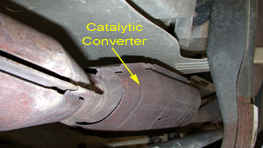
Description: Closely resembling a muffler in appearance, the catalytic converter is located in the exhaust system and has an outer shell made of stainless steel. The similarity with a muffler ends there as catalytic converters contain a catalyst made from a noble metal such as platinum, palladium or rhodium. A catalyst is defined as anything that induces or accelerates a change. At least one catalytic converter has been used on cars since 1975; today, cars may have two or more depending on the engine configuration and manufacturer.
Purpose: Using its internal catalyst, a catalytic converter's job is to greatly reduce the level of harmful emissions in a car's exhaust. Namely, these are carbon monoxide, hydrocarbons and oxides of nitrogen. All of these emissions are serious health and environmental hazards, plus they contribute to the formation of photochemical smog. A catalytic converter changes these poisonous gases to harmless carbon dioxide, nitrogen, oxygen, and water. In a simplistic way, the catalytic converter can almost be thought of as an engine of its own. The converter uses fuel and oxygen to "light off" its internal catalyst, which consumes a large portion of the gases flowing through the converter. Although a converter greatly reduces emissions, it does not eliminate them altogether.
Maintenance Tips/Suggestions: Catalytic converters do not require maintenance of their own, but their long-term livelihood depends on proper care and maintenance of your vehicle. As an example, if your vehicle begins to run rough, produces smoke from the tailpipe, or the SERVICE ENGINE SOON or CHECK ENGINE light appears, have it checked out immediately by a professional technician. This is especially true if the SERVICE ENGINE SOON or CHECK ENGINE flashes rather than being steadily lit. Neglecting these warning signs can cause expensive damage to the converter, requiring replacement. Symptoms of a faulty or failing converter may include failing an emissions test, poor performance, increased engine temperature, and bucking or hesitation.

